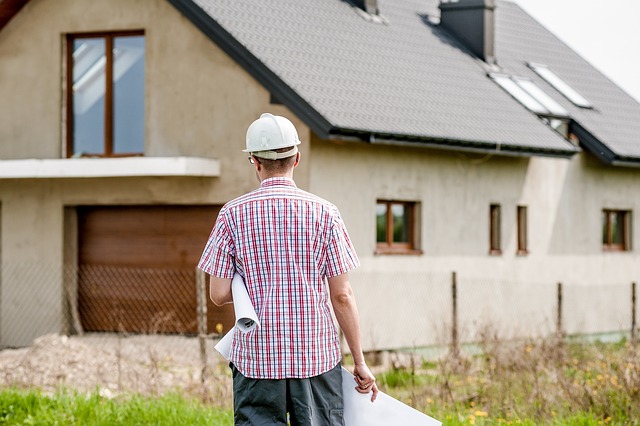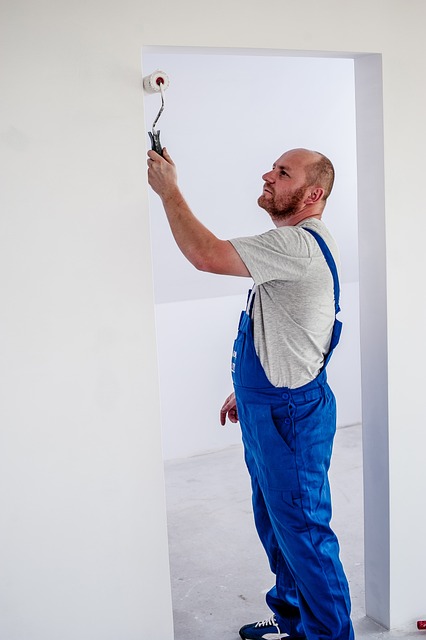Regular and diligent home repair and maintenance, with a special focus on roof inspections, are essential for protecting your home from environmental damage and avoiding costly repairs. A routine inspection schedule as part of your home maintenance plan can significantly extend the lifespan of your roof by catching minor issues like shingle wear or leaks early. Homeowners should be vigilant, checking for signs of roof degradation such as shingle granules in gutters, curled or cracked shingles, and proper sealing around chimneys, vents, and skylights. After severe weather, it's advisable to have a professional inspect the roof for hidden damage. Clear gutters and maintain the integrity of flashing are also critical for preventing water damage and structural issues. Seasonal checks by experts are recommended for aging roofs to ensure their ability to protect against weather intrusion. Proactive home repair and maintenance, including regular attic inspections and addressing underlayment and insulation issues, can effectively safeguard your home's integrity against the harmful effects of water infiltration, thereby preserving its safety and comfort over time. Adhering to these practices as recommended by Home Repair And Maintenance experts can help extend your roof's lifespan and prevent significant structural damage.
Effective home maintenance, particularly roof repairs and regular inspections, plays a pivotal role in preserving your residence’s structural soundness. This article delves into the significance of proactive measures to safeguard against leaks and ensuing damage, offering insights on common roofing issues, a comprehensive DIY inspection guide, and advice on when professional assistance is necessary. By integrating essential maintenance tips, homeowners can not only prolong their roof’s lifespan but also mitigate the risk of water intrusion. Understanding and acting on these practices will help ensure your home remains a secure and dry haven for years to come.
- Understanding the Importance of Timely Roof Repairs and Inspections for Sustaining Your Home's Integrity
- Identifying Common Roofing Issues That Can Lead to Leaks and Damage
- Step-by-Step Guide to Conducting a DIY Roof Inspection
- Professional Roof Inspection Services: When to Call an Expert
- Essential Maintenance Tips to Extend Your Roof's Lifespan and Prevent Water Intrusion
Understanding the Importance of Timely Roof Repairs and Inspections for Sustaining Your Home's Integrity

Regular inspections and prompt repairs are indispensable for maintaining the integrity of your home, particularly when it comes to the roof—your first line of defense against the elements. Neglecting this aspect of home repair and maintenance can lead to costly damages over time. A well-maintained roof not only shields your living space from rain, snow, wind, and debris but also safeguards the structural soundness of your abode. Early detection of issues like shingle wear, cracking, or leaks through periodic inspections can prevent more extensive problems that might compromise the safety and comfort of your home. By integrating a routine check-up schedule into your home repair and maintenance plan, you can anticipate and address minor repairs before they escalate into significant, and potentially expensive, fixes. This proactive approach not only extends the lifespan of your roof but also preserves the overall value and safety of your property. Homeowners who stay vigilant with their roof’s health are rewarded with a durable and reliable barrier against the outdoor environment, ensuring that their home remains a safe haven for years to come. Regular maintenance is thus a critical component in the long-term care of your home, reducing the likelihood of unforeseen and costly repairs due to neglect or deferred action.
Identifying Common Roofing Issues That Can Lead to Leaks and Damage

Regular home repair and maintenance are crucial for safeguarding your residence against leaks and subsequent damage, particularly in the roofing system. Homeowners should be vigilant in identifying common roofing issues that can lead to water intrusion and structural problems. One of the primary indicators of potential leaks is the presence of shingle granules in the gutters or downspouts; these granules protect the asphalt from UV rays, and their loss often signals the end of their useful life. Additionally, curled, cracked, or missing shingles can compromise the integrity of the roof, allowing water to seep through. It’s important to inspect these issues during routine home repair and maintenance checks, as they can escalate from minor repairs to significant and costly replacements if left unaddressed.
Another common issue is the deterioration of flashing around chimneys, vents, and skylights. These areas are prone to leaks because they are points where different surfaces meet. Home repair and maintenance should include a thorough examination of these junctions to ensure they are properly sealed with a durable, weather-resistant sealant. Moreover, the underside of gutters and valleys where roofs intersect can also collect debris and moisture, leading to rot and leaks. Regular cleaning and inspections during home repair and maintenance routines can prevent these issues from becoming more serious. By staying proactive with these checks, homeowners can mitigate the risk of water damage, protect their homes’ structural integrity, and save money in the long run.
Step-by-Step Guide to Conducting a DIY Roof Inspection

Regular roof inspections and timely repairs are crucial for maintaining the integrity of your home’s structure and ensuring the safety and comfort of its occupants. When it comes to detecting issues like leaks, wear and tear, or storm damage, early detection through a DIY roof inspection can save you from more extensive (and costly) repairs down the line.
To begin your DIY roof inspection, start by safely accessing your roof. Clear debris from the gutters and ensure that all the components such as flashing around vents and chimneys are intact. Use a sturdy ladder and consider bringing along a pair of binoculars to inspect hard-to-reach areas. Inspect the shingles or tiles for any signs of wear, such as curling, cracking, or missing pieces. Check for algae, moss, or granule loss, which can indicate aging or potential water infiltration points. Pay special attention to valleys and joints where leaks often originate. After the external inspection, a thorough internal check is necessary. Look for stains on the ceiling or attic rafters, musty smells, or light peeking through the roof boards, all of which can signal a leak. Document any issues you find, noting their locations and severity, which will help professionals assess the extent of repairs needed should you decide not to undertake them yourself. Remember to take your time and perform this inspection after extreme weather events or at least twice a year to catch potential problems early. With careful observation and diligent record-keeping, you can effectively monitor your roof’s condition and address issues before they escalate into costly home repair and maintenance challenges.
Professional Roof Inspection Services: When to Call an Expert

Regular home repair and maintenance, particularly on the roof, are pivotal in safeguarding your property against the elements and preventing costly repairs down the line. Homeowners often wonder when it’s time to call upon professional roof inspection services to ensure their homes remain secure and dry. The answer lies in understanding the typical lifespan of a roofing system and recognizing the signs that indicate an impending issue. Most residential roofs are designed to last between 20 to 30 years, but factors like weather conditions, installation quality, and the type of materials used can significantly affect this span. It’s wise to schedule a professional inspection after extreme weather events, as high winds, hail, or heavy snowfall can cause damage that may not be immediately visible but can lead to leaks and water intrusion over time. Additionally, homeowners should consider an annual inspection as part of their routine home repair and maintenance regimen, especially if the roof is nearing the end of its lifespan. This proactive approach helps identify minor problems before they escalate into major, more expensive ones. Professional inspectors bring specialized knowledge, equipment, and a keen eye for detail to assess your roof’s condition accurately, ensuring that any potential issues are caught early on. This not only protects the structural integrity of your home but also safeguards your family’s safety and comfort.
Essential Maintenance Tips to Extend Your Roof's Lifespan and Prevent Water Intrusion

Regular inspections and timely maintenance are crucial for extending your roof’s lifespan and safeguarding against water intrusion, which can lead to costly repairs or even structural damage to your home. To maintain the integrity of your roof, it’s advisable to conduct seasonal inspections, particularly after extreme weather events. Look for signs such as missing shingles, cracked seals, and worn flashing, which can all compromise your roof’s defenses against moisture. Clearing gutters and downspouts of debris is another important task, as this ensures proper drainage and prevents water from pooling near the roof line.
In addition to physical inspections, a professional assessment can provide deeper insights into your roof’s condition. Home Repair And Maintenance experts often recommend sealant maintenance around vents, chimneys, and skylights, as these are common entry points for water. Additionally, assessing the health of your roof from the attic can help you identify leaks or weak spots early on. By addressing issues like damaged underlayment or insufficient insulation, you can proactively prevent water from penetrating your home’s structure. Employing these essential maintenance tips not only extends the lifespan of your roof but also protects your home from the damaging effects of water intrusion.
Regular roof repairs and inspections are critical measures for preserving your home’s structural integrity. As detailed in the article, proactive maintenance can mitigate the damage from leaks, safeguard against costly repairs, and extend the lifespan of your roof. By familiarizing yourself with common roofing issues, such as those outlined, you are well-equipped to perform routine DIY inspections or recognize when professional expertise is necessary. Remember, consistent vigilance plays a pivotal role in maintaining your home’s safety and value. Home Repair And Maintenance practices, including the ones discussed, should be integrated into your property upkeep regimen to ensure long-term durability and peace of mind.
